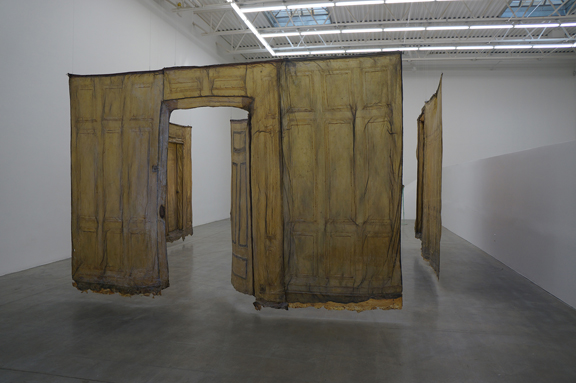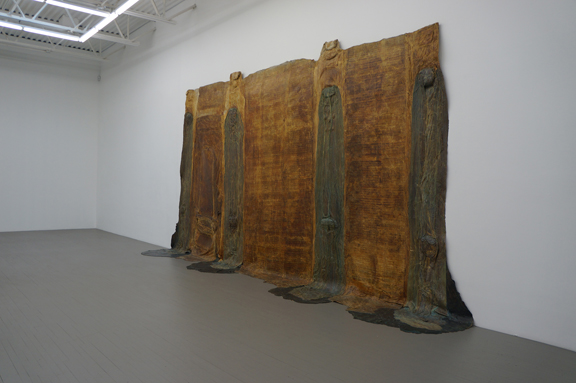Viewing Heidi Bucher’s explorations of
materiality, space and the body for the first time brought about the feeling
that the work could not be any more comfortable within the lineage of seventies
Postminialism, but I haven’t seen her work in any exhibitions or books on the
subject. It turns out that until this exhibition presented by Swiss Institute her
work had not been
presented in a U.S. institution since her series Bodyshells exhibited
at the Los Angeles County Museum of Art in 1972.
The “Raumhaut” (room skins), which Bucher began after moving back to Switzerland in the mid-seventies, fill the main space of the Swiss Institute. The works, latex and fabric layered casts of interiors and architectural elements, exude a ghostly and fleshy indexical materiality that lands somewhere between Eva Hesse's aesthetic of latex biomorphic surfaces and the content of Gordon Matta-Clark's architectural ruins.

The first of these molds, Untitled
(Herrenzimer) (1977-1979), hangs in the center of the exhibition
space’s lower platform in the manner that now makes viewers think of Do
Ho-Suh’s fabric architectures. Molded from the master bedroom’s of Bucher’s
parent’s home and installed to recreate three walls of the space, including the
droopy cast of an open door, the installation grants visitors an entrance into
nostalgia that seeps from the walls. Untitled (Herrenzimer)’s indexical
nature seems to assume an added weight and ghostly ethereality with Bocher's
personal reference as the wrinkled and sagging walls turn what was originally
architecture into a body.
The other notable mold hangs from the wall with a different sense of grandiosity than Untitled (Herrenzimer). The monumental 1987 cast Grande Albergo Brissago (Eingangsport) replicates, or rather memorializes, an ornate hotel entryway with mold-green columns and classical detailing. The cast, once a wall itself, seeps downs from its support into giant puddles, and what might have once been details of the a lavish décor are lost in the folds. The peeled layers seem to take with them a biographical surface quality from their models, a certain aspect of their liveliness that coats and obscures the surface of interiors over time like dust, but with a certain pathetic attempt at emulating their original.
The other notable mold hangs from the wall with a different sense of grandiosity than Untitled (Herrenzimer). The monumental 1987 cast Grande Albergo Brissago (Eingangsport) replicates, or rather memorializes, an ornate hotel entryway with mold-green columns and classical detailing. The cast, once a wall itself, seeps downs from its support into giant puddles, and what might have once been details of the a lavish décor are lost in the folds. The peeled layers seem to take with them a biographical surface quality from their models, a certain aspect of their liveliness that coats and obscures the surface of interiors over time like dust, but with a certain pathetic attempt at emulating their original.

As with Body
Shells, the room skins are put into a significantly new perspective with
the insight of the films presented in the Swiss Institute’s basement. Raume
sind hullen, sind Haute (Rooms are surroundings, are skins) (1981) is
a thirty-two minute film showing the process behind the “Raumhaut.” It reveals the playfulness with which Bucher
approached her work. She slides between the freshly dried cast and walls to
pull them apart and on to her self, leaving the room wearing the walls like
her Bodyshells. This
disparity between object that exudes a process art ethos and actual documented
process complicates the work but hopefully more recognition and exhibitions
will follow and clarify Bucher’s practice and art.
Great review! I think you have a good understanding of Heidi Bucher’s work. Like you’ve mentioned, she has not exhibited since her series Bodyshells in 1972. It was a nice add-on to reference other artists like Eva Hesse in a materialistic aspect and Gordon Matta-Clark for content. I also thought the room skins were put into a new perspective in the gallery space compared to the film of Bucher removing the skins from the walls and wrapping herself “like her Bodyshells.”
ReplyDelete